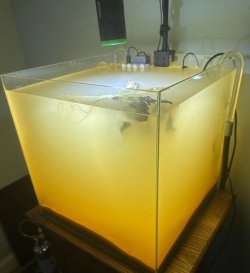I ignore the haziness caused by suspended silt. If you simply start cycling the tank the haziness will eventually clear up. In my experience the tanks follow the same progression when new substrate is added. Assuming weekly 50% water changes. Timeframe is highly subjective and dependent of starting conditions, these are from my experiences only. I experiment with substrate changes often and frequently had to setup new tanks when breeding fish. All my setups are seeded with filter substrate and plants from my established aquariums to speed up the process.
(0-2 days)
I setup the initial decoration and planting. Let the tank settle for a couple of days then vacuum the surface of accumulated silt that drops out of the water. (removes the heavy silt particles from the tank)
(2 - 14 days)
I then start the filter, and setup the lighting, I might put a polishing pad in the filter but this is not always necessary. The water might have high turbidity still but just ignore it. This is caused by small silt and clay sized particles which would take months to settle out. If you have enough plants you can even have fish in the tank at this stage because the silt and clay doesn't seem to bother them. At this point I only clean the front glass, I want to encourage the biofilm development.
(14 day time frame usually)
The tank should now be developing a biofilm. With the particulate in the water, light, and filtration running this is often the time frame that you can get a bacterial/algal bloom, there is high inorganic nutrient loading in the tank at this time. I view this a good thing. In my experience I start with a light whiteish haze that slowly gets worse as the particulate haziness reduces, this whitish haziness transforms to a full on green algal bloom in a few days. The blooms are beneficial because the algae and bacteria typically grow about the microscopic silt and clay particles. This is when I almost always use a polishing pad in the filter, I leave the pad in as one of the initial stages in the filter, removing it every 24 hours and back rinsing the pad before placing it back in the filter. In my opinion, this traps the ultra fine particles within the localized bloom organisms and the polishing pad helps remove the extra particles. The remainder become "sequestered" within the tank.
(21 days usually)
The tank is more or less clear, there might still be some haziness with the silt and clay but most is gone now. I no longer use a polishing pad reverting to my typical filter media of a pre filter followed by coarse sponge and ceramic biomedia. As the tank ages its ability to deal with mineral based silt just gets better. This is the timeframe I usually add fish unless I have an urgent need earlier.
(Long term)
Over the long term the nutrient level in the tank from organic sources usually increases. After the initial blooms you can expect any other bloom are due to organic nutrient loading not mineral nutrient loading and must be dealt with in a different manner (I try to avoid this situation). I deal with the nutrient loading by keeping Nitrate to 10 ppm and never over 20, essentially not feeding the fish heavily. Heavy feeding or fertilization must be combined with more water changes, and plant pruning so that the nutrients within the tank do not build up (closed system you have to remove the excess nutrients). I feed my fish at a rate where they still graze slightly on the plants, they are after the biofilm. I also make the pre-filter accessible to the fish so that they graze the food it traps before it goes into the filter proper.
I have had some substrates not show any cloudiness but that is mostly with previously used gravel, not sand. Sand typically has more silt and clay so I almost always have a bit of a bloom with sand. I would also state that I wash my sand pretty heavily before I put it in tank, spending up to 4 hrs to rinse 1.5 cubic feet of sand for one of my larger tanks. Overall once a decent biofilm is established the silt gets trapped pretty quick. By its nature the biofilm in the tank is your most efficient cleaner.


